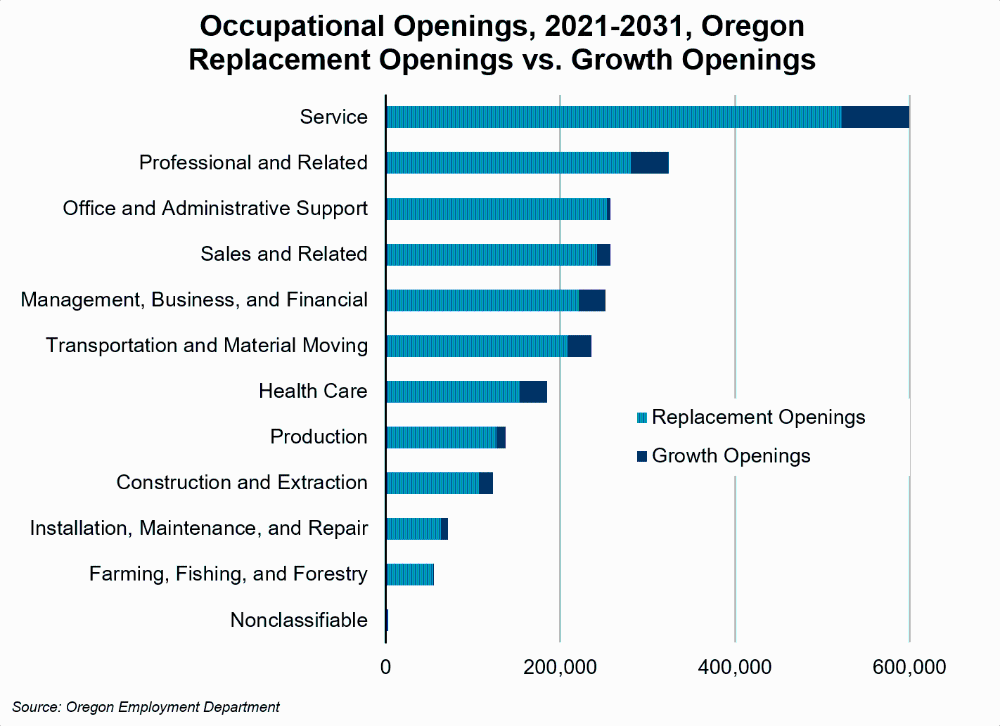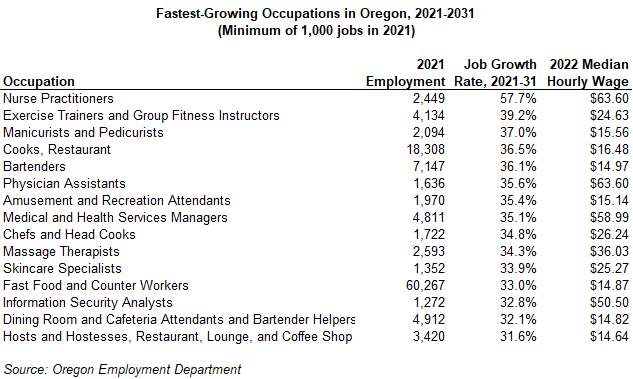10-Year Occupational Projections Show Recovery and Growth
February 9, 2023Oregon’s total employment will grow 13% (265,000 jobs) between 2021 and 2031, according to new projections from the Oregon Employment Department. Employment growth reflects recovery from low employment levels in 2021 due to the pandemic recession in addition to structural growth. In addition, many job openings are expected due to the need to replace workers who leave their occupations.
Where Are the Job Openings Focused?
Among the broad occupational groups, service (+24%) tops the list for fastest growing by 2031. Service occupations, which include food preparation and serving workers, personal appearance workers, protective services, and building and grounds cleaning, rank first with the most job openings. The fast growth in service occupations is mainly caused by the job losses incurred in 2020. Service occupations require face-to-face interaction with consumers and many workers in this group lost their jobs. Service occupations made up 16% of jobs in 2021 and are projected to comprise 24% of the job openings over the decade.

Over this period most job openings are projected due to the need to replace workers leaving their occupations. Nine out of 10 job openings (2.2 million) are expected due to the need to replace workers who retire, leave the labor force for other reasons, or make a major occupational change, with the remaining openings due to new or expanding businesses. Replacements overshadow growth openings in all broad occupational categories.
Detailed Occupations
Occupations expected to have the most job openings include fast food workers, retail salespersons, cashiers, stockers and order fillers, waiters and waitresses, and home health and personal care aides.
In terms of fastest-growing, 10 of the 20 fastest-growing occupations with 2021 employment of 1,000 or more are occupations that are heavily concentrated in leisure and hospitality. They include cooks, bartenders, hotel desk clerks, exercise trainers and group fitness instructors, and amusement and recreation attendants. These occupations are fast growing due to the job losses incurred in leisure and hospitality in 2021. Health care occupations and those associated with health care made up four of the fastest-growing occupations from 2021 to 2031. By comparison, in the last set of projections prior to the pandemic, health care occupations (including mental health) accounted for 13 of the 20 fastest-growing occupations.

The fastest-growing occupations associated with health care include nurse practitioners, physicians assistants, medical and health services mangers, and massage therapists.
Other top-growing occupations are related to other services – manicurists, pedicurists, and skincare specialists. The fast growth in projected employment for manicurists, pedicurists, and skincare specialists is driven by the job losses in beauty parlors and facial salons in 2020.
On the other end of the scale, employment levels among several occupations are expected to decline. That includes executive and legal secretaries, data entry keyers, bank tellers, telemarketers, executive secretaries and administrative assistants, bill and account collectors, and file clerks.
Education
In 2021, six out of 10 jobs in Oregon typically required a minimum of high school education or less. To meet more competitive requirements for Oregon's jobs, six out of 10 required education beyond high school.
Occupations with the most job openings typically requiring a high school diploma or less include fast food workers, retail salespersons, cashiers, stockers and order fillers. Those requiring a postsecondary certification or associate’s degree include truck drivers, bookkeepers, and medical and nursing assistants. Occupations with the most job openings requiring at least a bachelor’s degree vary from general and operations managers to registered nurses, project management specialists, software developers and accountants.
Additional Information
The 2021-2031 employment projections for Oregon are produced for about 100 industries and 800 occupations. More information on industry and occupational projections for Oregon and sub-state areas can be found at QualityInfo.org/projections.